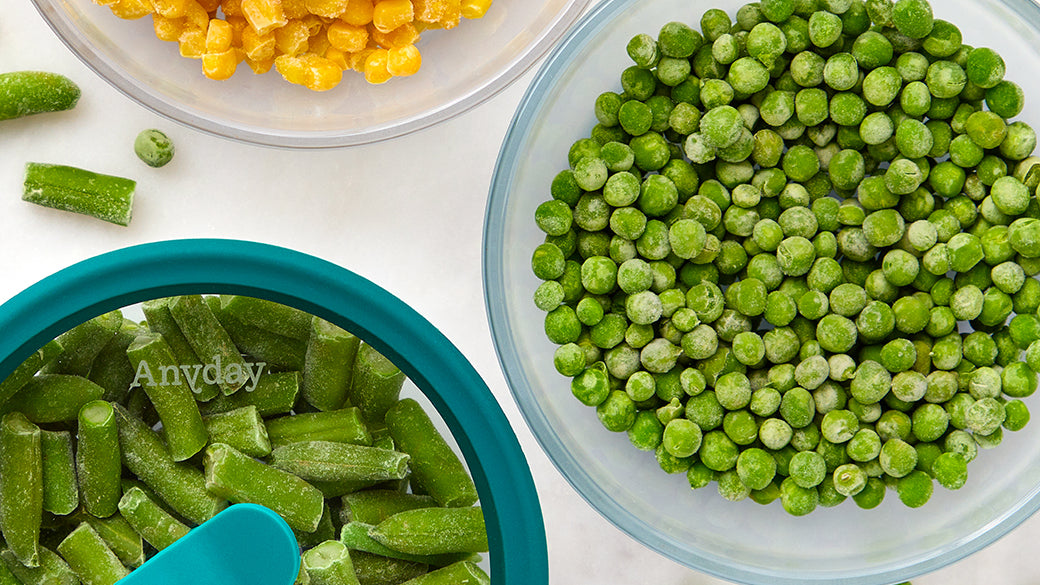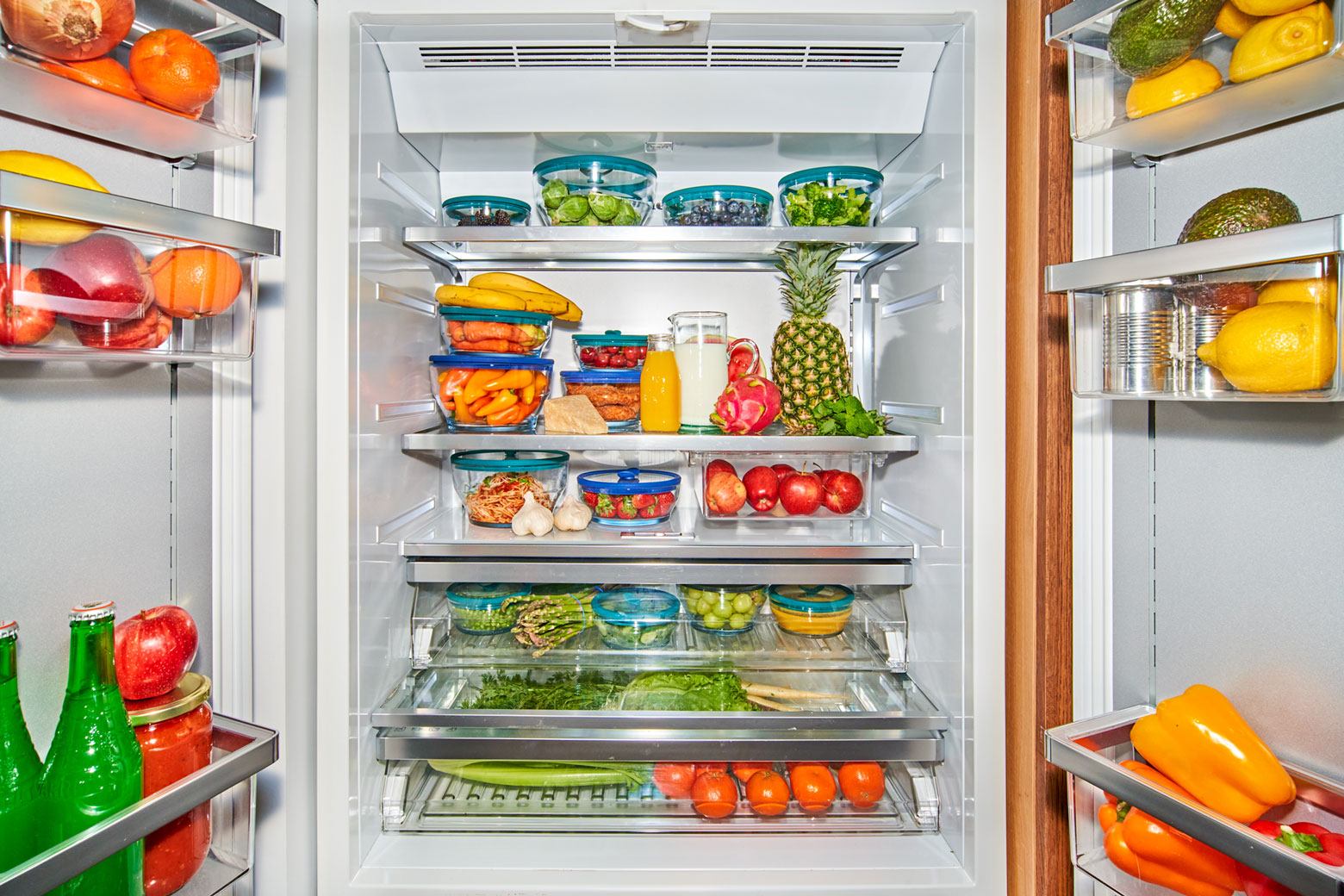We’ve all had this terrible realization at one point or another: The chicken you were planning to make for dinner is still in the freezer, solid as a rock. With the countdown to supper on, can you still make a delicious meal? Is teriyaki chicken or creamy Tuscan chicken still within reach? It sure is! Yet again, the magic of the microwave comes to the rescue, safely defrost frozen foods in minutes.
Microwaves can be a great time-saving appliance for defrosting, but knowing the right technique is key to achieving the best (and safest) results. Cooking food from frozen can be tricky and affect the taste and texture of your food if done incorrectly.
Don't worry, Anyday dishes are here to help. Our vented lid is designed to create the perfect container for steam to build up just enough to defrost, but not cook your food. The contained environment concentrates the steam, rather than distributing it throughout the appliance, making it more efficient way of cooking.
There are a few methods to properly defrost frozen food and meals in the microwave. Here’s a comprehensive guide on how to defrost various types of food using your microwave effectively and safely:
Defrosting tips for perfect results
By following these tips, you'll achieve more consistent results when defrosting frozen food in your microwave:
- Start with short intervals: Begin by defrosting food in the microwave for 1-2 minutes, then check and adjust. Overcooking food will result in unpleasant taste and texture, so keep an eye on the process.
- Flip or stir halfway: Flip or stir your food halfway to ensure even defrosting and prevent cooked spots.
- Use glass dishes: Don't defrost food in the plastic or styrofoam tray it was stored in. Transfer to a glass dish like an Anyday to avoid exposure to plastic, which leaches toxins into foods when heated (yes, even if it says “microwave safe”!).
- Separate pieces: If defrosting items like chicken breasts or fish filets, separate them as they start to thaw for more even defrosting. If you can’t separate the pieces at first, defrost for a minute or two and separate the pieces before continuing to microwave.
As always, it’s important to follow these tips as they are important in considering food safety. Once you’ve exposed the food to a rapid change in temperature, it is important to cook food immediately to prevent bacteria growth.
Why is it better to defrost frozen food in the microwave compared to other methods?
Once food is taken out of its consistent temperature environment (like the fridge or freezer), you’re taking it into the ‘food danger zone’ where the internal temperature of the food is between 40°F and 140°F. Once you do this, you have a limited amount of time before bacteria can grow rapidly and reach dangerous levels. In terms of time it takes to defrost food, the microwave proves its prowess yet again, taking just a few minutes to achieve fully thawed food.
There are a few ways to defrost food in a bowl of water on the counter or under running water, but all of those methods take much longer compared to microwave method (like an hour or even more!). Plus, you’re creating waste by changing out the water every 30 minutes or slowly running water out of the faucet. Finally, using water to defrost food typically requires a layer of protection (say, a plastic bag?) to prevent the food from becoming water-logged. If you’re looking to save precious water resources and avoid using plastic all together, the microwave and an Anyday dish are the best way to go.
How to properly use the microwave’s power level or defrost settings
Did you know that 90% of households in America have a microwave? That’s quite a few appliances, which also means that not all machines are made the same. Defrost or power level settings can vary between microwaves, so always check your microwave’s manual to make sure you have the correct settings.
There are two main ways to thaw food in the microwave: the defrost setting or adjusting power levels. The defrost setting is best when you know the weight of the food you’d like to thaw, but it’s also a bit of a mystery as to how your machine calculates the time. When you leave it up to your microwave to figure out how long it’ll take to defrost the food, you run the risk of over- or undercooking the food. We recommend checking the food after 2 minutes anyway, but sometimes this hands-off approach can lead to accidentally overcooking food.
How to defrost food using the microwave ‘defrost’ setting
Setting the defrost function can vary significantly between different microwave models. For the most accurate instructions, be sure to follow the directions provided in your microwave's manual.
- First, note the weight of the food you’d like to defrost.
- Place the food you want to defrost into an Anyday dish and cover with the lid.
- Press the defrost function, enter the weight of the food, and press start.
- Flip the food halfway through for best results.
How to defrost food using the ‘Power Level’ setting
Setting power levels can vary significantly between different microwave models. For the most accurate instructions, be sure to follow the directions provided in your microwave's manual.
- Place the food you wish to defrost into an Anyday dish and cover with the lid.
- Press the Power Level button to select Power Level 2 or 20% power. If you need more instructions on how to change your power level, read this article.
- Flip the food halfway through for best results.
My microwave doesn’t have a power level setting — can I defrost food on full power?
If your microwave is limited in function and doesn’t offer either setting, you can try a more hands-on approach to defrost food. When working with full power, it’s important to pay attention and microwave in short, 15-second bursts and wait 30 seconds in between each cooking cycle to achieve a similar effect. While manually tending to the process is more tedious, overall you will spend less time waiting for the food to thaw in the fridge or under running water.
Defrosting Step-by-Step
How to defrost meat in the microwave
To defrost frozen chicken, beef, turkey, and other meats safely:
- Place the frozen meat in an Anyday dish and cover with the lid.
- Set your microwave to ‘Defrost’ or adjust the power level (Power Level 2 or 20% Power).
- If using the defrost setting, enter the meat’s weight if prompted. This helps some microwaves adjust the cook time automatically.
- Start with 2-3 minutes, then pause to check and flip or rearrange the meat. Add more time if needed, but don't overdo it. Pay attention to the surface of the meat drying out or white spots forming on the surface. These are signs that the meat is cooking on the outside.
- The meat is ready when its still slightly cold, but not frozen. Proceed to use the meat in your favorite recipe.
Note: It is safe to thaw meats on the bone (such as chicken wings and pork chops) in the microwave, but you may need to consider how large the bone is and adjust the cook time accordingly. Start with 2-3 minutes per side and add more cook time if needed.
How to defrost frozen vegetables in the microwave
For quick and even defrosting of frozen vegetables:
- Add the frozen vegetables to an Anyday dish and cover with the lid.
- Set your microwave to ‘Defrost’ or adjust the power level (Power Level 2 or 20% Power).
- Enter the weight if prompted.
- Start with 1-2 minutes, then stir the vegetables and check for any remaining frozen bits.
Add more time if needed, but take care not to start the cooking process. Without added moisture, you might get a stringy and unpleasant texture. If you plan on adding these vegetables to a recipe, it won’t matter too much if they are still slightly cold. They’ll warm up by the time the recipe is cooked.
How to defrost bread and baked goods in the microwave
To gently thaw frozen bread or baked goods:
- Add the frozen bread to an Anyday dish and cover with the lid. If the loaf doesn’t fit into the dish, you can cut it in half or just microwave as-is.
- Set your microwave to ‘Defrost’ or adjust the power level (Power Level 2 or 20% Power).
- Enter the weight if prompted.
- Start with 20-30 seconds, then check to see the progress. Continue in 10-15 second bursts until the bread is soft and no longer cold.
Pro Tip: To revive a loaf’s crispy exterior, preheat an oven to 400°F. After microwaving the loaf, briefly run it under water and immediately place the bread onto the wire rack of the oven.
How to defrost soups, sauces, and stews in the microwave
Safely thaw frozen soups, sauces, and stews by:
- Place the food in an Anyday dish, and cover with the lid.
- Use defrost or a low power setting (Power Level 2 or 20% Power).
- Enter the weight if prompted.
- Start with 2-3 minutes, then stir. Break up larger frozen chunks with a spoon and stir before microwaving for more time.
- Food is ready when it is consistent in texture and warmed through.
Pro Tip: Freezing soups, sauces, and stews in large blocks can lead to long cook times. Use Anytime 1/2 cup Freezer Trays to freeze these items into smaller portions, allowing steam to gently thaw these frozen foods more quickly and evenly.
The microwave is the best way to defrost food
It’s no secret: the microwave is our favorite appliance in the kitchen and defrosting frozen food in minutes just adds a whole other reason to love this mighty machine. Whether you’re looking to thaw meat, fish, vegetables, full meals, and more, the microwave is the fastest, safest, and most efficient way to thaw food.





Share:
10 Budget Items to Stock in Your Kitchen
How to Freeze and Reheat Food in the Microwave Using an Anyday Dish